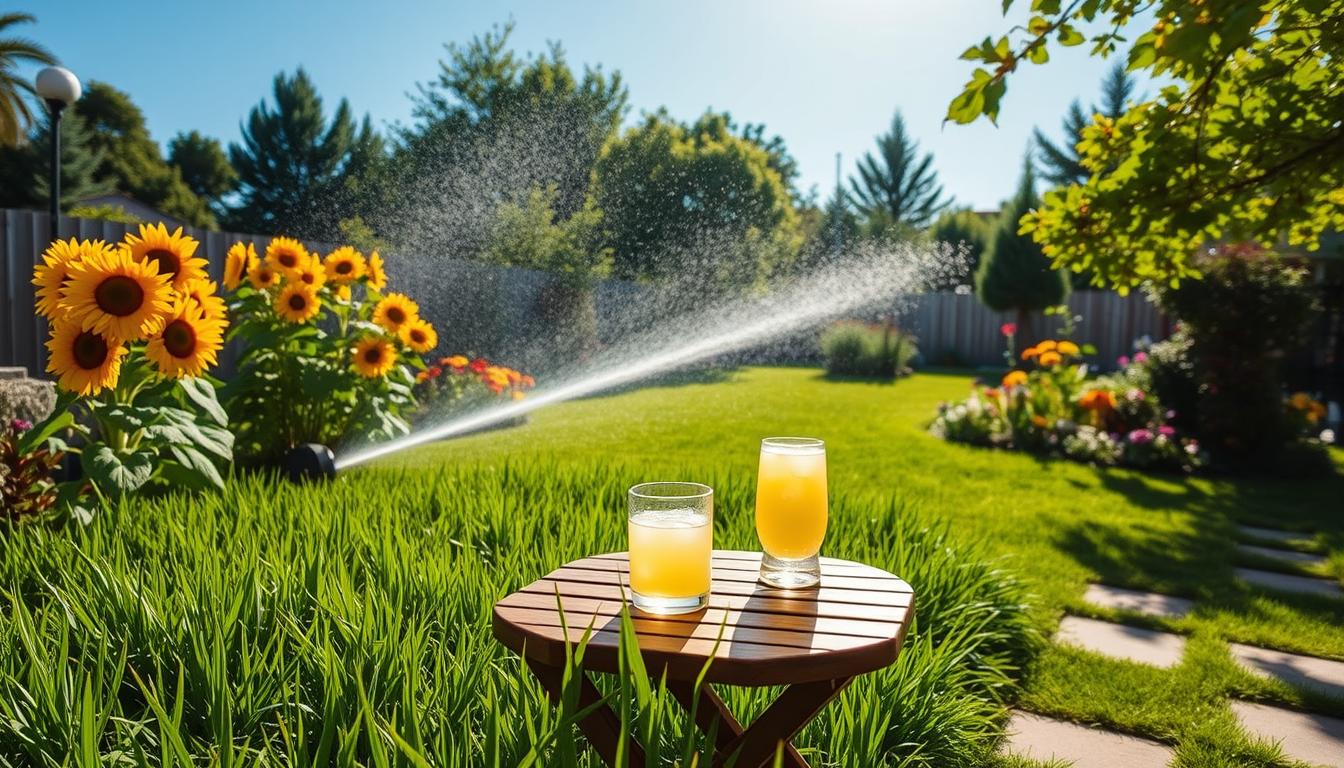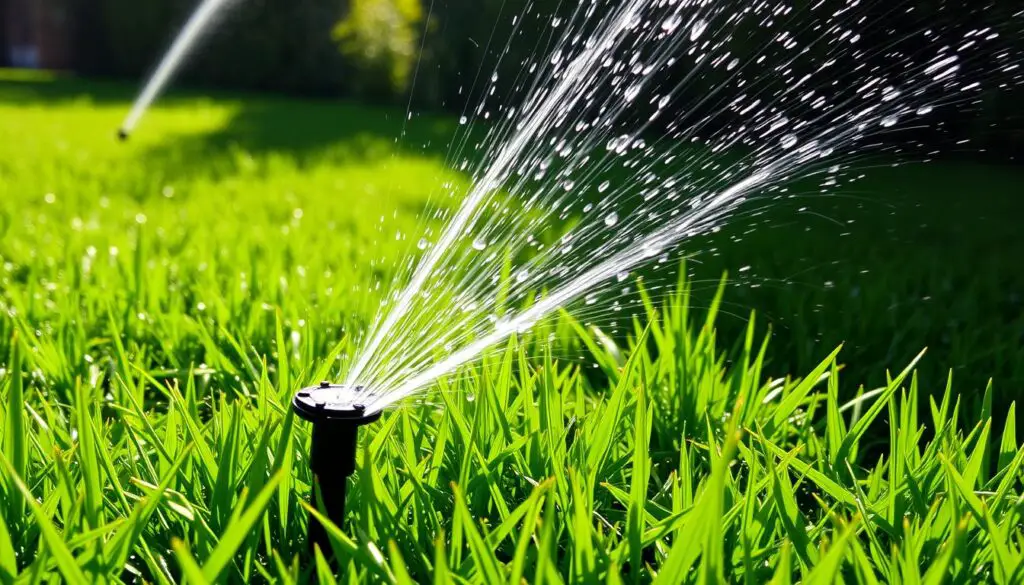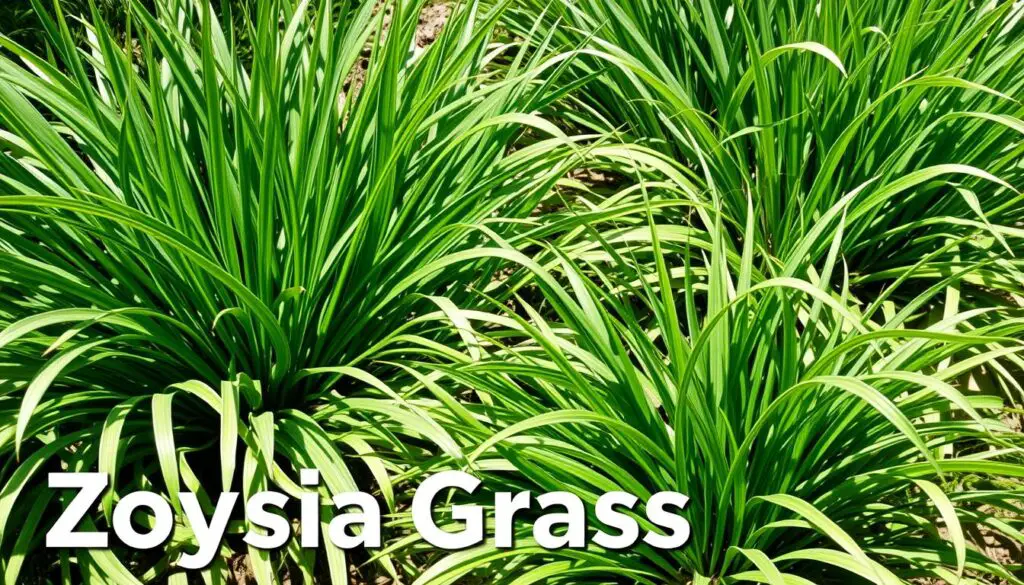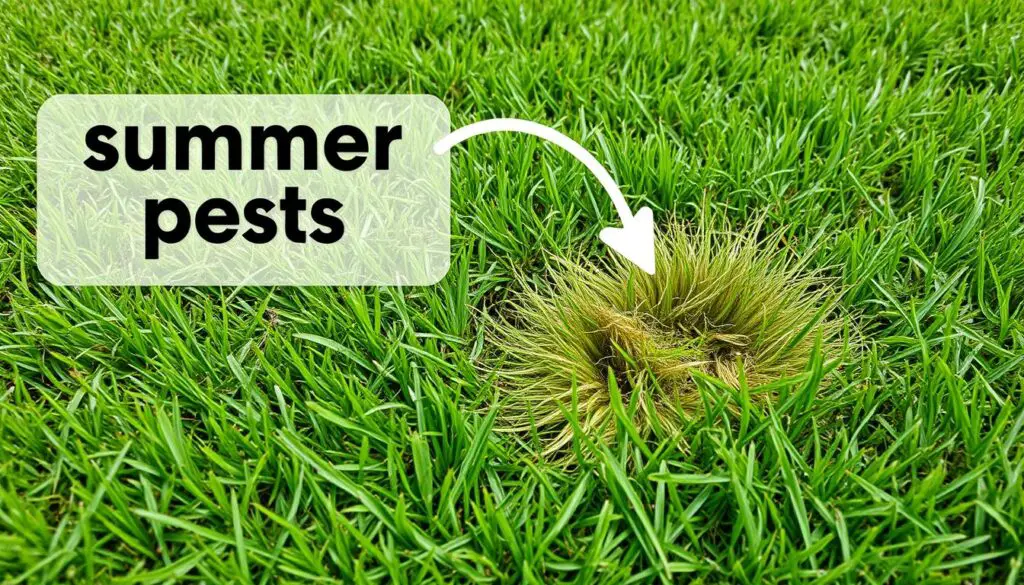How to Keep A Green Lawn in Hot Weather: Lawn Care in Summer

Master essential lawn care in summer techniques to keep your grass green and thriving, from watering tips to weed control and heat-tolerant grass solutions.
Did you know that within 6-8 weeks of feeding, the microbes in your soil have processed most of the nutrients for your lawn to absorb?
This little-known fact is just the tip of the iceberg when it comes to maintaining a lush, vibrant lawn during the scorching summer months. As a homeowner, I’ve faced the challenge of keeping my grass green and thriving, even in the face of soaring temperatures and prolonged dry spells. But with the right strategies and techniques, it’s entirely possible to achieve the lawn of your dreams, no matter the weather conditions.
In this comprehensive guide, I’ll share my proven tips and tricks for keeping your lawn healthy and green throughout the hot summer season.
From mastering the art of watering and mowing to addressing weed control and lawn aeration, you’ll learn everything you need to know to ensure your grass stays vibrant and lush. So, whether you’re dealing with lawn care in summer, creating an optimal watering schedule, or preventing heat stress, this article has you covered.
Key Takeaways
- Understand the importance of proper watering techniques to keep your lawn thriving during hot weather
- Learn how to utilize the right mowing techniques to prevent damage and promote healthy grass growth
- Discover effective weed control and lawn aeration strategies to ensure your lawn stays lush and vibrant
- Explore the benefits of using the right fertilizer and choosing drought-tolerant grasses to maximize your lawn’s resilience
- Leverage shaded areas and pest management techniques to protect your lawn from the elements and potential threats
Understanding the Causes of Lawn Discoloration
Summer heat makes keeping a lawn green a big challenge. Knowing why lawns turn patchy is key. Things like bad watering, disease, and pests can all cause problems.
Improper Watering Habits
Bad watering is a top reason for lawn discoloration. Too much shallow watering weakens the roots. This makes grass more likely to turn brown in hot, dry weather.
Watering at the wrong time, like in the afternoon, makes things worse. This is because evaporation is higher then.
Incorrect Mowing Techniques
How you mow can also hurt your lawn. Cutting it too short stresses the grass. This can make it turn brown and patchy.
Keeping the grass at the right height is important. It helps your lawn stay healthy and green.
Disease and Pest Infestations
Diseases and pests can also make lawns look bad. Fungal diseases like brown patch and dollar spot can turn grass yellow or brown. Pests like grubs and chinch bugs cause brown spots.
Quick action is needed to fight these problems. This helps keep your lawn looking good all summer.
Mastering the Art of Watering
Lawn care in summer requires careful attention to watering schedules to keep grass from drying out. Proper lawn watering is key to a lush, green lawn in summer. Knowing the right techniques can make your lawn stand out. Let’s dive into the main principles of watering your lawn well.
Soaking the Grass During Dry Spells
To keep your lawn healthy, water it deeply but not too often. Water your lawn 3-4 times a week, aiming for 1 inch of water each week. This method encourages deep roots, helping your lawn stay green even in dry times.
Monitoring Water Flow and Runoff
Watch how water flows and runs off when you water. Adjust your schedule to avoid waste and ensure the soil absorbs the water. Using a buried irrigation system with timers can make watering more efficient.
Adjusting for Rainfall
Changing weather means you need to adjust your watering. Turn off sprinklers when it rains to save water and keep your lawn balanced.
| Watering Recommendation | Suggested Amount |
|---|---|
| Minimum Water Requirement for Cool Season Grasses | 1 inch per week |
| Recommended Watering Frequency | 1/8 inch per day |
| Best Watering Time | Early morning (6 a.m. – 10 a.m.) |
By using these lawn watering techniques, you’ll get a deep soaking, efficient water flow monitoring, and timely rainfall adjustments. These are the secrets to a vibrant, healthy lawn all summer.
“The most important factor in maintaining a lush, green lawn is proper watering. Neglecting this vital aspect can lead to discoloration, disease, and an overall unhealthy appearance.” – Lawn Care Expert

The Importance of Proper Mowing
Mowing height is essential for effective lawn care in summer, helping grass stay green and resilient.
Maintaining a healthy, lush lawn starts with proper mowing techniques. As summer heat increases, it’s key to know the best grass length and mowing frequency. This ensures your lawn stays vibrant even in the hottest months.
Maintaining an Optimal Grass Length
Finding the right grass length is crucial for a healthy lawn. Cutting the grass too short can stress the roots and cause damage. Instead, keep it a bit longer to help the roots grow deeper and access more moisture.
- Warm-season grasses like Bermuda and Zoysia should be mowed to a height of 1-2 inches.
- Cool-season grasses like Fescue should be mowed to a height of 3-3.5 inches.
By keeping the grass at the optimal length, you’ll not only promote a lush, green appearance. You’ll also help the lawn better withstand summer’s challenges.
Mowing Frequency
Mowing more frequently can also contribute to a well-manicured lawn. Instead of letting the grass grow too long, mow every 5-7 days during the peak growing season. This keeps the lawn neat and prevents overgrowth.
“Mowing your lawn at the right height and frequency is crucial for maintaining a healthy, green appearance.”
Remember, the key to proper lawn mowing is finding the right balance between grass length and mowing frequency. By following these guidelines, you’ll be well on your way to a stunning, summer-ready lawn.
Feeding Your Lawn Regularly
Effective lawn care in summer includes using the right fertilizer to strengthen your lawn against heat stress.
To keep your lawn green and healthy in the summer, it needs regular nutrients. Soil microbes take about 6-8 weeks to break down and make nutrients available. So, it’s important to fertilize your lawn every 6-7 weeks to keep it growing well.
Understanding Nutrient Cycles
Extreme weather can cause soil to lose nutrients. This means you need to add these nutrients back slowly. Using a slow-release fertilizer helps your grass get nutrients without burning it during the summer.
Choosing the Right Fertilizer
- Choose a balanced fertilizer like Scotts Turf Builder for healthy roots.
- For Bermuda and Zoysia grasses, use a high-nitrogen formula for strong growth.
- Organic options, like Milorganite, are safe for kids and pets.
- Adding weed control to your fertilizer helps keep your lawn looking great.
Knowing about nutrient cycles and picking the right fertilizer keeps your grass green and healthy all summer.
Weed Control and Lawn Aeration
Practicing good lawn care in summer means tackling weeds early to reduce competition for nutrients. Keeping your lawn green and weed-free is a big challenge in the summer. Weeds fight for water and nutrients with your grass. It’s important to pull weeds by hand as soon as you see them. This way, you avoid using weed killers that can harm your grass.
Aerating your lawn also helps a lot. It makes holes in the soil so air, water, and nutrients can get to the roots. This makes it harder for weeds to grow and keeps your lawn healthy.
Timely Weed Removal
Weeds are a big problem in Texas lawns. Pulling them by hand as soon as you see them is the best way to control them. This stops them from spreading and taking over your lawn.
Aerating for Better Absorption
Aeration can be an important part of lawn care in summer, helping roots get the air and water they need.
Aeration is key in the dry summer months. It makes it easier for water, air, and nutrients to get to the roots. Texas homeowners spend an average of $145 on professional lawn aeration services. You can also rent a mechanical aerator or use a garden fork to aerate your lawn yourself.
| Soil Type | Aeration Frequency |
|---|---|
| Sandy Soil | Once a Year |
| Clay Soil | Twice a Year |
| Loamy Soil | Once a Year |
| Chalky Soil | Twice a Year |
Aeration is great for warm-season grasses like Bermudagrass and Zoysiagrass. These grasses do well in Texas’ weather. Aerate them from May to September for the best results. Cool-season grasses like fescues should be aerated in September to November or March to April.

“Aeration is essential to allow air, water, and nutrients to reach grass roots and maintain lawn health during hot, dry weather.”
Addressing Wear and Tear
As warmer months arrive, our lawns face more wear and tear. Pets, kids, and outdoor fun can leave bare spots and thin grass. But, overseeding in the fall can fix this.
Overseeding spreads grass seed over your lawn to thicken and repair it. The fall’s cooler weather and more moisture are perfect for seed growth.
Overseeding in the Fall
Fall is the best time for overseeding. Here’s why:
- Cooler temperatures help seeds grow better.
- More moisture from autumn rains and dews helps roots grow.
- It lets new grass grow strong before winter.
Adding overseeding to your fall lawn care can fix summer damage. It prepares your lawn for a healthy start next year.
“Overseeding is a game-changer for lawns that have seen better days. It’s an easy and effective way to thicken up the grass and fill in those unsightly bare spots.” – Sam Masser, Author and Mowing Specialist
Don’t stop caring for your lawn after summer. Keep up with fall tasks like overseeding. This keeps your grass lush and green all year.
Considering New Grass Varieties
If your lawn is struggling with the summer heat, it might be time for a change. Look for heat-tolerant grasses and drought-resistant grasses. These grasses, like some fescue, bermuda, and zoysia, stay green and healthy even when it’s hot.
Heat and Drought-Tolerant Options
When picking a new grass, consider these heat and drought-tolerant options:
- Fescue: Fescue has a deep root system, making it more drought-tolerant. It also does well in partial shade, making it versatile for many areas.
- Bermuda Grass: Bermuda grass is tough in hot, dry weather. It’s a top pick for southern lawns, needing less water than other grasses.
- Zoysia Grass: Zoysia is slow-growing but very durable. It handles heat, drought, and lots of foot traffic well. It’s perfect for hot, dry areas.
Switching to these new grass varieties can keep your lawn looking lush and green all summer.

“Choosing the right grass type for your local climate and soil conditions is key to maintaining a healthy, thriving lawn year-round.”
Lawn Care in Summer
A shaded lawn area can help ease summer lawn care by reducing water loss and soil temperature. Keeping your lawn green in summer needs a smart plan. You must balance watering, mowing, and feeding your grass. This way, your lawn stays beautiful all summer.
Watering Wisely
Lawn care in summer is easier with heat-tolerant grass varieties that handle high temperatures well. Watering right is key for a healthy lawn in summer. Give your grass 1 inch of water each week, from rain or irrigation. Watering in the early morning helps save water.
Don’t overwater, as it can cause diseases and other issues.
Mowing at the Right Height
Set your mower to 3 1/2 to 4 1/2 inches high in summer. This keeps the grass moist and helps it grow strong. Sharp blades and leaving clippings on the lawn add nutrients.
Fertilizing for Vibrant Growth
Fertilizing regularly keeps your lawn green. Use a summer fertilizer like Scotts® Turf Builder® SummerGuard® Lawn Food with Insect or Scotts® Turf Builder® Summer Lawn Food. Apply every 5-6 weeks, except in August.
Preventing Weeds and Pests
Keep your lawn weed-free with spring pre-emergent herbicide and spot treatments. Scotts® GrubEx® Season Long Grub Killer also protects against grubs.
By using these summer lawn care and hot weather lawn maintenance tips, your lawn will stay lush and vibrant all summer.

Protecting Your Lawn from Pests and Diseases
As summer gets warmer, lawn lovers need to watch out for threats to their grass. Warm weather brings more pests and diseases that can harm your lawn. By being alert and taking action early, you can keep your lawn safe from these invaders.
Brown patch is a common summer disease, caused by fungi in hot, humid weather. It shows up as large, circular brown spots with a green center.
Dollar spot creates small, silver-dollar-sized brown areas.
Summer patch affects Kentucky bluegrass and fine fescues, causing circular patches of dead grass with green centers.
Grubs, sod webworms, and chinch bugs are pests that can harm your lawn in summer. Grubs eat grass roots, causing brown patches. Sod webworms and chinch bugs suck fluid from grass, making it brownish.
| Lawn Disease | Characteristics | Optimal Conditions |
|---|---|---|
| Brown Patch | Large, circular brown patches with green centers | Hot, humid weather |
| Dollar Spot | Small, silver-dollar-sized patches of brown or straw-colored grass | Warm, moist conditions |
| Summer Patch | Circular patches of dead grass with green centers | Affects Kentucky bluegrass and fine fescues |
To fight pests and diseases, use proper watering, mowing, and fertilizing. A healthy lawn can fight off threats better. Watch your lawn closely and fix problems fast to stop them from getting worse.
By being proactive, you can keep your lawn safe from summer pests and diseases. With some effort and the right steps, your lawn will stay green and healthy all summer.
Utilizing Shade and Mulch
Using natural and man-made elements can greatly help your lawn in the summer. Placing trees, shrubs, or structures around your lawn can block direct sunlight. This reduces heat stress on the grass. Adding organic lawn mulch helps keep soil moist and controls temperature, protecting the grass.
Providing Relief from Direct Sunlight
Strategic shade placement can greatly improve your lawn’s health and look. Shaded areas give your grass a break from the sun. This keeps your lawn lush and green all summer.
Man-made structures like trellises or pergolas can also block sun. They’re great where natural shade is lacking. Try different setups to find the right mix of shade and style for your space.
“Mulching your lawn is another powerful tool in your summer lawn care arsenal. The organic material helps retain soil moisture, regulate temperature fluctuations, and suppress weed growth – all critical factors in maintaining a healthy, vibrant lawn.”
Combining lawn shade and lawn mulch protects your lawn from the summer sun. This approach keeps your grass strong and makes your outdoor space more beautiful. Enjoy your outdoor area all season long.
Adjusting Your Expectations
Keeping my lawn healthy is a big job, but I’ve learned to adjust my expectations in summer. Even with great care, my grass might look different. I’ve come to accept the natural changes in my lawn’s look.
“In the hot summer, I focus on keeping my lawn healthy. I know it will look great again when it cools down and rains more in fall. By changing my expectations, I enjoy my outdoor space more and don’t get upset by seasonal changes.” – Sam, author
A healthy lawn doesn’t always look perfect. By focusing on long-term health, my lawn stays strong and ready for any season. This way, it thrives through the year.
FAQ
What are the primary causes of lawn discoloration during the hot summer months?
How often should I water my lawn during the summer?
What is the optimal grass length for maintaining a healthy, green lawn?
How often should I fertilize my lawn during the summer?
How can I effectively control weeds in my lawn during the summer?
What can I do to address the wear and tear on my lawn during the summer?
Are there any grass varieties that are better suited for hot, dry summer conditions?
How can I protect my lawn from pests and diseases during the summer?
How can I provide relief for my lawn during the hottest summer days?
Should I expect a lush, green lawn year-round, even during the summer?
Source Links
- https://scotts.com/en-us/lawn-care-101/easy-ways-to-maintain-a-healthy-lawn-in-the-summer.html
- https://www.skh.com/thedirt/lawn-healthy-heat/
- https://patuxentnursery.com/blog/tips-for-keeping-your-lawn-green-in-the-summer/
- https://weedman.com/blog/diagnosing-heat-stress-on-your-lawn
- https://puregreenllc.com/blog/lush-lawn-even-in-summer-preventing-and-treating-heat-stress/
- https://todayshomeowner.com/lawn-garden/guides/why-your-lawn-is-turning-brown/
- https://baylandscaping.net/summer-watering-tips
- https://bayscape.net/lawn-care-tips/
- https://lawnlove.com/blog/summer-lawn-care-tips/
- https://turfmasterslawncare.com/2020/07/20/summer-mowing-101
- https://www.lawnstarter.com/blog/lawn-care-2/summer-lawn-care-guide/
- https://thelawncarenut.com/blogs/news/how-to-water-and-fertilize-your-lawn-in-summer?srsltid=AfmBOoqzHVFA3xYxlN3Jrz4UXM-ca8-7OwHD53lBt0NfG0t0-W3j8bGd
- https://bioadvanced.com/lawn-care-keeping-lawns-healthy-summer-lawn-watering-guide
- https://www.terra-lawn-care.com/summer-lawn-fertilizer-guide/
- https://www.lawnstarter.com/blog/texas/when-to-aerate-lawns-texas/
- https://www.greenseasonslawns.com/blog/summer-lawn-care-101/
- https://bakersacehardware.com/blogs/news/summer-to-fall-lawn-care-tips-keep-your-lawn-healthy-all-year-round
- https://doehlinglandscape.com/blog/seasonal-lawn-care-tips-preparing-your-lawn-for-each-season
- https://www.rhs.org.uk/lawns/spring-summer-care
- https://kappslawn.com/seeding-success-choosing-the-right-grass-variety-for-your-lawn/
- https://luvalawn.com/maximize-your-lawns-resilience-summer-care-tips-for-a-healthy-yard/
- https://bladesofgreen.com/lawn-care/summer-lawn-care-tips/
- https://scotts.com/en-us/lawn-care-101/summer-lawn-care-tips.html
- https://www.rootedinnaturemd.com/post/maryland-summer-lawn-care-do-s-don-ts
- https://www.greenviewfertilizer.com/articles/protect-your-lawn-from-disease-damaging-insects-during-the-summer-months
- https://nexgreen.com/effective-strategies-to-combat-summer-lawn-diseases/
- https://realgreenservices.com/how-to-maintain-a-healthy-lawn-through-the-intense-texas-heat/
- https://www.bogleheads.org/forum/viewtopic.php?t=242325
- https://www.grassworksaustin.com/6-tips-for-lawn-care-in-the-texas-summer-months/
- https://www.zuper.co/blog/guide-to-seasonal-lawn-maintenance-schedule
- https://news.vt.edu/articles/2024/07/extreme-heat-drought-lawn-care-experts.html
- https://extension.oregonstate.edu/gardening/lawn/how-grow-maintain-healthy-lawn

